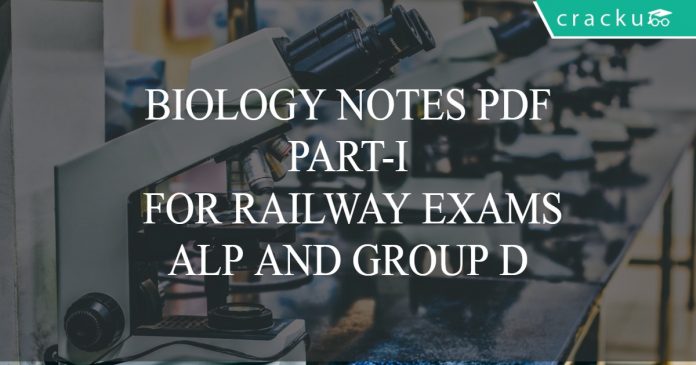Biology Notes PDF for SSC, Railways & Competitive Exams – Important One -liners (PART-1):
Download Biology notes PDF useful for class 11th, class 12th, SSC CGL, CHSL Competitive exams, UPSC (Civil services – IAS) and RRB NTPC, ALP & railway Group-D.
Get 200 SSC mocks for just Rs. 249. Enroll here
Download Biology Notes set-2 PDF
Take a free mock test for SSC CGL
IMPORTANT SCIENTISTS RELATED TO BIOLOGY
| A Biologist best known for his science of evolutions | Charles Darwin |
| French Biologist known for his discoveries of the Principals of Vaccination and Pasteurization | Louis Pasteur |
| American Molecular Biologist known for his contribution to the discovery of structure of DNA with Francis Crick and Rosalind Franklin in 1953 | James Watson |
| Scottish Physican known for his discovery of enzyme and the world’s first antibiotic substance benzyl penicillin (Penicillin G) | Alexander Fleming |
| German Microbiologist credited as the founder of modern bacteriology | Robert Koch |
| Renowned Swedish Botanist Known for Binomial Nomenclature, Taxonomy | Carl Linnaeus |
| German botanist and co-founder of Cell Theory along with Theodor Schwann and Rudolf Virchow | Matthias Jakob Schleiden |
| Italian biologist and physician, who is referred to as the Father of microscopical anatomy, histology, physiology and embryology | Marcello Malpighi |
| German Jewish physician and scientist who worked in the fields of hematology, immunology, and antimicrobial chemotherapy | Paul Ehrlich |
| Austrian biologist, physician, and immunologist credited with the development of Blood Group System, discovery of Rh Factor and Poliovirus | Karl Landsteiner |
| French physician who won the Nobel Prize in Physiology in 1907 for his discoveries of parasitic protozoans as causative agents of infectious diseases such as malaria and trypanosomiasis | Charles Louis Alphonse Laveran |
| Estonian scientist considered as the founding father of embryology | Karl Ernst von Baer |
| Romanian-American cell biologist. Described as “the most influential cell biologist ever”, in 1974 he was awarded the Nobel Prize in Physiology and Medicine along with Albert Claude and Christian de Duve | George Emil Palade |
| Dutch microbiologist and botanist and often considered one of the founders of virology and environmental microbiology | Martinus Beijerinck |
General Science Notes for SSC/RRB PDF
IMPORTANT ON-LINERS IN BIOLOGY FOR RRB EXAMS (ALP AND GROUP D), SSC EXAMS, UPSC EXAMS
- Cell is the basic building block of all living Organisms, it is the smallest unit of Organisation in a living thing.
- There are two types of Cells: Prokaryotes and Eukaryotes
| Prokaryotes | Eukaryotes |
| Cells of Organisms which have no defined nucleus | Cells of Organisms which has a defined nucleus |
| Uni – Cellular | Multi – Cellular |
| No Cell Organelles | Multi Cell Organelles with Special Function |
| Bacteria | Fungi, Animals and Plants |
| Cell Membranes : Compartments of cell surrounded by a thick membrane are called Cell Membrane, which is common to both the types of cell and that holds all cell fluids inside and keeps foreign body away from the Cell | |
- Cell was first discovered and coined by Robert Hooke in 1665
- Theory of Cell is first credited to Theodor Schwann and Matthias Jacob in 1830s
- Cell Nucleus was first described by Franz Bauer in 1804 however, the discovery is credited to Scottish Botanist Robert Brown in 1831 for his detailed description of Cell Nucleus
Constituents of a Cell:
- Cell Organelles: Organelles are observed in Eukaryotic Cells which have definite shape of nucleus, Cell Organelles use membrane to distinguish their functions from the rest of the Organelles Example of Cell Organelles : Mitochondria, Golgi Apparatus, Ribosome etc…
- Endocytosis: The process of engulfing matter by a living cell to be utilized for the energy-using process. Amoeba uses this process for processing of food
- Substances like CO2 and Oxygen move through the cell membrane by a process called Diffusion.
- Osmosis is the process of movement of molecules through a semi-permeable membrane into a region of higher solute concentration in the direction that tends to equalize the solute concentration on both the sides.
- Water molecules are transported through the cell membrane by this process of Osmosis
- Osmosis is a case of Diffusion (through a semi-permeable membrane)
- Protein and Fat help in building the cell membrane which is known as cell biogenesis
- The Fluid in a cell excluding the Nucleus containing Organ Cells that perform specific functions of the cell is called Cytoplasm
- The cell organelle which combines simple molecules into complex molecules and packages them into vesicles and sends them out of the cell is called Golgi Apparatus
- Digestion of any foreign material is done by lysosomes to keep the cell clean, in one way it is the waste disposal system of the cell.
- The Power House of the cell – Mitochondria, energy required for various cell processes is released by Mitochondria through ATP (Adenosine-tri-Phosphate) molecules
- ATP (Adenosine-tri-Phosphate) is referred to as the Energy Currency of the cell
- The Cell Division is initiated by the Centrioles
- Chromosomes carry all the information that is required by the cell to grow, divide and reproduce
- The cell organelles which are found only in plants are Plastids
| Leucoplasts | Chloroplasts |
| Protein, Starch and Oil are stored in Leucoplasts | Primarily for imparting colors to fruits and flowers. Chloroplast contain chlorophyll which is the site of Photosynthesis in Plants |
- Large network of membrane bound tubes similar in structure to Plasma Membrane where Proteins, Fat Molecules are manufactured is called Endoplasmic Reticulum (ER), There are two types of Endoplasmic reticulum
| Smooth Endoplasmic Reticulum | Rough Endoplasmic Reticulum |
| Helps in manufacturing of Fat Molecules or Lipids | Helps in manufacturing of Proteins |
| These lipids and proteins are used as Hormones and Enzymes in the body | |
| One Major use of ER is detoxification of many poisons and drugs is liver cells of Animals | |
| ER is both a manufacturer and a passage way for Intracellular transport | |
SSC CGL Previous Papers Download PDF
SSC CHSL PREVIOUS PAPERS DOWNLOAD
- The process in which water is purified in the cell by removing the impurities when it flows from a dilute solution (hypotonic) to a concentrated solution(hypertonic) through a semi permeable membrane is called Reverse Osmosis. In this process, little pressure is applied to overcome the Osmotic Process
- The Non-Living Part Cell Organelles of the Cell are Vacuoles and Granules
| Granules | Vacuoles |
| Stores – Fat, Proteins and Carbohydrates. |
Stores – Excess Water, Minerals, Pigments and Waste Products |
| Not supported by any membrane | Fluid filled spaces enclosed by Membranes |
- The Brain of the Cell – Cell Nucleus which control the different processes in the cell
| Cell Nucleus consists of the following main parts | |||
| Nuclear Envelope | Chromosomes | Nucleolus | Chromatin |
| Membrane similar to cell membrane covering the Nucleus | v Chromosomes are the ones which carry information.
v They are made up of DNA and similar pattern of DNA is called Gene v A Human-Being Usually has 23 Pairs of Chromosomes or (46 Chromosomes) |
A small dense spherical structure in the nucleus of a cell
Proteins are stored by the nucleolus |
The DNA in the cell nucleus is packaged by special proteins called histones. The protein/DNA complex formed is called Chromatin |
- There are two types of process in cell division
| Mitosis | Simplest Duplication of a cell and all its parts. Five Steps are involved in the processProphase, Metaphase, Anaphase, Telophase and Interphase |
| Meiosis | Four Cells are formed from the process of Meiosis during reproduction. It can be looked at as two simultaneous phases of Mitosis creating four cells from one original cell |
- On the Basis of functions performed by different tissues, they are classified into
| Epithetical Tissue | – Covering or Protective tissues from Mechanical Injuries and Invading Micro organisms
– These tissues are tightly packed and form a continuous sheet – The intercellular spaces in these tissue is negligible – Cells of epithelium play a crucial role in exchange of materials between the body and the external environment – The main function of the SQUAMOUS is to protect the parts from injury, germs etc is found mainly in the walls of blood vessels and air sacs of lungs |
| Connective Tissue | Most abundant and widely distributed tissues in the animal body There are four types of connective tissues : Arelor, Adipose, Skeletal, Fluidl |
| Muscular Tissue | Muscle Tissues are of three types:
Skeletal(Voluntary), Smooth(Involuntary) and Cardiac(Involuntary) |
| Nervous Tissue | This tissue is the major tissue in the body which controls the body responsiveness to changing conditions
The Brain, Nerves and Spinal Cord compose of the nervous tissue |
- Endocrine is a collection of gland which secrete certain chemical messages called hormones
- Endocrine glands lack ducts and are also called as ductless glands
- Different endocrine glands present in the human body are
| Pituitary | Located in a bone cavity called sella tursica
Secretes : |
| Pineal | Located on the dorsal side of the forebrain Secretes : Melatonin – Helps in maintaining the Sleep-Wake cycle , Body Temperature etc… |
| Adrenal | Located at the anterior part of each kidney
Comprises of two tissues: Adrenal Medulla – secretes adrenaline and noradrenaline |
| Thyroid | Located on either side of Trachea Secretes : T4 – Throxine T3 – Triiodothyronine Iodine is essential for the synthesis of Hormone in Thyroid GlandDeficiency of Iodine causes Hypothyroidism and enlargement of gland known as GoiterThyroid hormone also assist in formation of Red Blood Cells, Metabolism, Water and Electrolyte Balance and calcium levels in Blood |
| Pancreas | Pancreas is a composite gland containing exocrine and endocrine system
Contain Millions of Islets of Langerhans which contain a-cells – which secrete Glucagon and p-cells – which secrete Insulin |
| Parathyroid | Present on the Backside of the Thyroid Gland
Secretes : Parathyroid Hormone (PTH) which increases the calcium levels in the blood |
| Thymus | Located behind the Lungs on the ventral side of oarta
Secretes : Thymosins |
| Gonads | Consists of important parts TESTIS and OVARY |
HORMONES
Hormones are classified into three types based on their structure
| Steroids | These are lipids derived from Cholesterol. These are secreted by Gonads, Adrenal, Cortex and Placenta |
| Peptides | Majority of the hormones are peptides, they are characterized by short chain of amino acids and are secreted by Pituitary, Parathyroid, Heart, Stomach, Liver and Kidneys |
| Amines | These are derived from amino acid tyrosine and are secreted from Thyroid gland and adrenal medulla |
- Antagonism is the paired process of contraction and simultaneous expansion of various muscles in the body
- Immunity is the body’s ability to repel foreign substances and cells
- Cell Wall is absent in Animals
- Cells in an animal burst when surrounded by Hypertonic medium
- Cells in Plant doesn’t burst when surrounded by Hypertonic Medium due to the presence of Cell Wall
- Lysosomes are also called the Suicidal Bags of a cell
- Water constitutes the major component of the cell
- The chemical process that occurs in a living organism to continue life is called Metabolism
- Carbohydrates are the important biomolecules that are a major part of the living organisms. They are also called as the Hydrates of Carbon and are primarily produced by Plants
| Some Important Carbohydrates | |
| Sucrose | Commonly used sugar in day to day life is a disaccharide which on hydrolysis gives glucose and fructose |
| Lactose | Carbohydrate present in Milk |
| Glucose | It is a monosaccharides, it can be hydrolyzed further into simpler unit aldehyde or Ketone Present mainly in sweet fruits, ripe grapes, Honey etc |
| Fructose | |
| Ribose | It forms the basic backbone of RNA |
| Galactose | It is a monosaccharide obtained by hydrolysis of Lactose with the help of enzyme Lactase |
| Starch | It is a ploy saccharide and is most commonly found carbohydrate in nature, it acts a storage material in plants and is an important dietary source for humans |
| Cellulose | Found as abundant organic substance in Plants |
| Glycogen | Similar characteristic of starch, stores carbohydrates in Animals mainly in liver and muscles |
- All proteins are polymers of Amino Acids
- Proteins synthesized in the body are called non-essential amino acids
- Proteins obtained through diet are called essential amino acids
- Proteins soluble in water are called Globular Proteins Ex: Insulin
- Proteins not soluble in water are called Fibrous Proteins Ex: Keratin
- Vitamins are organic compound required by the body to perform biological functions for growth and maintenance of the Organism
- Vitamins are generally classified as :
| Fat Soluble Vitamins | Water Soluble Vitamins |
| Soluble in Fat and Oils but insoluble in water, they are stored in liver | Soluble only in water |
| Vitamin : A,D,EK | Vitamin : B and C |
- The in-organic nutrients called as Minerals which are equally essential for the human body in small traces are
| Calcium | Potassium | Magnesium | Sodium | Copper | Iodine |
| Iron | Manganese | Zinc | Selenium | ||
- Fat – one of the three main macronutrients is also known as triglycerides which are esters of three fatty acid chains and alcohol glycerol
- Cholesterol and triglycerides are lipids, which are insoluble in water but soluble in alcohol
- The Blood Pressure is controlled by Adrenal Gland
- Any enzyme that converts proteins into peptides is called protease
| Micro Organism | Disease caused by the Micro Organism | Organism effected | Mode of Transmission |
| Fungi | Ringworm | Human | Skin Contact |
| Protozoan | Malaria | Human | Female Anopheles Mosquito |
| AIDS | Human Immuno Deficiency Virus | Humans | Blood exchange |
| Anthrax | Bacillus Anthraces | Mostly Animals including Humans | Infected Meat |
| Cholera | Vibrio Cholerae | Humans | Water / Food |
| Diphtheria | Bacterium Diptheriae | Humans | Air/ Direct contact |
| Pneumonia | Streptococcus Pneumoniae | Humans | Airborne droplets of sneeze |
| Plague | Yersinia Pestis | Human | Air/ Direct Contact |
| Tuberculosis | Mycobacterium | Humans | Air |
| Chicken Pox | Varicella Zoster Virus | Humans | Air |
| Cold, Influenza | Rhino Virus | Humans | Airborne |
| Dengue Fever | Flavivirus | Humans | Female Aedes Mosquito |
| Ebola | Ebola Virus | Humans | Animal to Human |
| Foot and Mouth Disease | Picornavirus | Animals | Animal to Animal |
| Amoebiasis | Entamoeba histolytica | Humans | Contaminated Water |
This PDF covers Biology Notes for Railways Exams ALP and Group D. Crack Government Exams the smarter way with “Cracku”
Cracku Wishes You All the Best for the upcoming RRB- ALP and Group D, SSC, NABARD Grade-A Assistant Manager, RBI Grade B and other Competitive exams.






[…] Biology Notes […]
[…] Biology Notes PDF for Railways Competitive Exams […]
[…] Biology Notes PDF […]